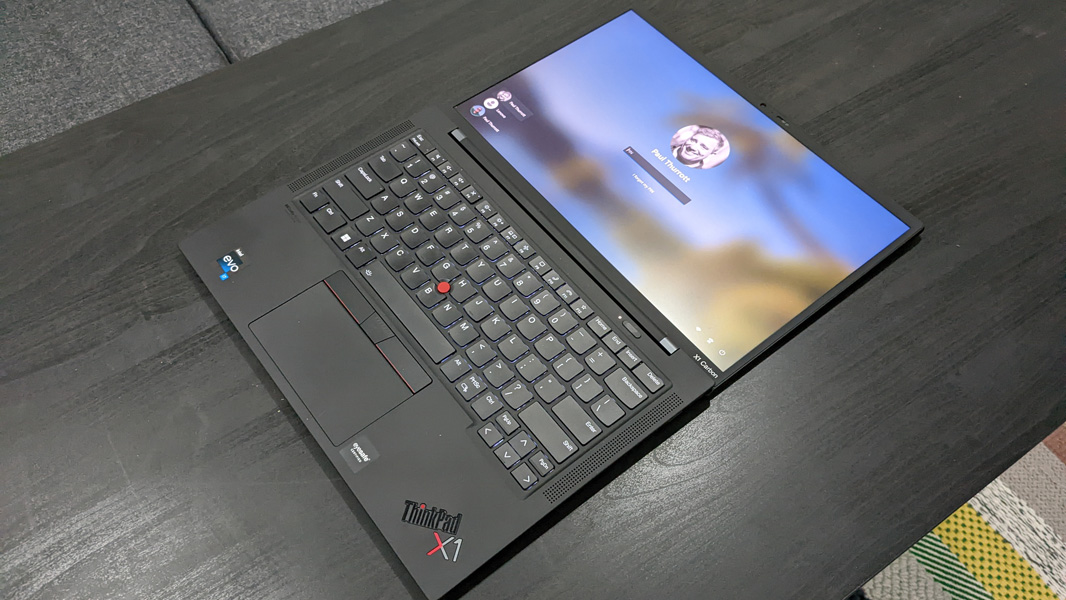The Carbon X1 demonstrates that engineers continue to struggle for the balance between battery performance and consumption. The 2022 model is undoubtedly a powerful platform, but it shortens the autonomy time relative to the laptop that Carbon replaces.
Pros:
- The classic style;
- The powerful processors;
- The Thunderbolt 4 port
- A great screen.
Cons:
- expensive;
- It takes more time from the battery.
- A weak memory.
Lenovo ThinkPad X1 Carbon (Gen 10) Review
The Lenovo ThinkPad X1 Carbon series of the 10th generation is designed to meet the needs of companies that are willing to invest heavily in hardware, but are not willing to waste their employees with expensive mobile workstations.
This may mean that you have a quite accessible laptop in front of you, which has undergone a lot of changes associated with hardware, which can easily be ruined by careless handling. Where the previous X1 Carbon shares the least with its successor, in hardware, as from the inside this laptop is an entirely new machine, every aspect of which has been modified or improved. Disappears the panel with the proportion of sides 16:9, which is replaced by a new 14-inch screen with a proportion 16:10, the new screen can be OLED and even with a resolution of 4K, but even in the basic configuration resolution above 1080p. We also noticed that the webcam became much better, raising the resolution to 1080p versus 720p, and the previous generation had a proprietary docking station adapter, which had to be abandoned because today docking stations with Thunderbolt are much more popular today.
But a significant difference is the new series of Intel mobile processors, which tries to erase the unpleasant history of the previous two or three generations. However, the new chipset has a completely different balance in terms of performance and efficiency, with the available battery taking you more working hours than before. Users who work from the network or have charging devices on the go are not going to experience problems, but those who expect to work a full day without recharge may be disappointed. In exchange for less autonomy time, you get an increase in performance that can cope with even the toughest office programs. The only weakness of performance is that the integrated Intel Iris Xe graphics doesn’t make the X1 Carbon the perfect choice for video editing or CAD applications, even if this graphics subsystem is better than the terrible UHD Graphics that was before.
And while numerous changes have been made, what remains is the core aesthetics of the ThinkPad, first imposed by IBM more than thirty years ago. This is a brand feature, even though today the red controller coming out of the keyboard is being used by fewer and fewer people, and the company more than seventeen years ago moved into its own other transnational corporation.
Review of Lenovo ThinkPad X1 Carbon Gen 10 (2022)
Processor: Intel Core i7-1260P 3.4 GHz to 4.5 GHz Boost;
Graphics: Intel Iris Xe graphics
Operating memory: 16 GB DDR4
Display: 14-inch OLED display with a resolution of 2880 x 1800p;
Samsung PM9A1 512 GB PCIe SSD Gen 4
Ports: x2 USB Type-C Thunderbolt 4, x2 usb Type-A 3.2 Gen 1, x1 HDMI 2.0b, x1 3.5mm combined headset/microphone connector, X1 Nano SIM slot (optional);
Connectivity: Wi-Fi 6E and Bluetooth 5.2
Camera: 2 megapixel front camera
OS: Windows 11 Pro
Weight: 1.12 kg
Size: 315,6 x 221,5 x 14,9 mm (Sh x G x V);
Battery: 4-element lithium-ion battery 57Wh with 65W adapter.
The starting price of the X1 Carbon seems reasonable until you realize that the base model features a Core i5 processor, 16 GB of RAM, IPS display (1920 x 1200) and no 5G support.
Choosing the configuration given in our review, the amount will have to increase more than twice, as a result, the cost of the laptop will quickly come to $ 2330 (175000p + VAT). One weirdness of American assemblies, for example, is the configuration of most processors with 16 GB RAM, and in order to get 32 GB of RAM, you will have to choose a configuration with the Core i7-1270P and above. All memory is attached to the board, so you will not be able to increase the amount of RAM on your own on lower-level configurations.
Lenovo ThinkPad X1 Carbon (Gen 10): Design
- light carbon fiber and magnesium;
- Features of ThinkPad;
- Good selection of ports.
As you get older, raising your laptop over the corner can lead to a moment of panic when your wrist joint decides to refuse at the most responsible moment. For users who have experienced this on their own, the 10th generation ThinkPad X1 Carbon is the perfect laptop, weighing only 1.12 kg, made from a very strong combination of carbon fiber and magnesium. The only problem with this manufacturing method is that the outer surface is covered with a rubber coating that easily attracts dust and dirt from which it is also almost impossible to remove fingerprints. If you can swallow the demanded price and the laptop’s ability to attract dust, you’ll be left with a very convenient laptop that includes the many features needed by mobile horse users.
So what is missing? The only obvious feature that many would like was an SD card reader, although Thunderbolt and USB ports are enough to easily connect the reader. Much less pragmatically, we treat the security sticker on one of the screws at the bottom of the laptop, which blocks users’ access to internal components. Why the manufacturer does this is unclear, but we have noticed that all assemblies come with RAM attached to the motherboard, unfortunately. Today, this trend is pursuing most ultrabooks, so expect to see more systems blocked in this way. Users who ignore the sticker will be able to replace the M.2 2280 NVMe drive, although you will need PCIe 4.0 interface and without a pre-installed radiator.
Design: 8 of 10
Lenovo ThinkPad X1 Carbon (Gen 10): Features
- the display;
- The Thunderbolt port.
- 5G is on the go.
- In the overview model, the most striking feature of the Carbon X1 is the screen;
OLED panels are characterized by powerful and constant lighting and rich colors that IPS TFT can’t compete with, the panel of our laptop is just magnificent. However, the panel resolution may seem strange to you (2880 x 1800), but it’s only 14 inches from angle to angle, making the default scaling equal to 200%. Apparently, the resolution on this Lenovo is excessive, which does not prevent Lenovo from offering 4K panel (not OLED) to users who want more pixels.
Where this panel can be justified by a high peak brightness of 400 nits. However, as OLED panels independently illuminate each pixel, unlike LED background lighting, we were surprised that 500-nits IPS actually turned out to be brighter than OLED displays. Another feature that should be mentioned is the 5G options to choose when ordering. Due to the global spread of the laptop, there are several variations of this technology based on different 5G/4G LTE modems, and it can happen that a laptop purchased in one region will not work in the event of an international trip. This is not something Lenovo can do, but it is worth knowing that regional compatibility in this matter is not guaranteed.
Specifications: 8 of 10
Review of Lenovo ThinkPad X1 Carbon Gen 10: Performance
- Excellent productivity overall;
- Laptop with NVMe desktop;
- Results of tests
When interpreting benchmarks, it is important to understand that the results are influenced by a variety of components. And depending on how they interact with each other, the final results are affected. The basis of this system is the Intel Core i7-1260P processor with 12 cores and 16 streams, capable of decorating any task. Obviously, the Core i7-1260P can be incredibly fast, especially in terms of multi-core operations, but results in single-core tasks can float. Users who want even more power in some regions will find assemblies offering even higher performance, including vPro models.
The problem we encountered when testing the X1 Carbon is that when the machine runs from the battery, the system seems to prefer to work on economical E-cords to save charge, but performance drops. When it connects to the socket, P-Cores enter the game to increase productivity. Or it is just a theory. Because sometimes, for some reason, the priority changes and the P-Core eats the time of autonomous work. You can configure settings to balance the laptop’s performance better, but by default, the X1 Carbon tends toward performance rather than savings. In addition to the huge amount of streams operated by the laptop, there are two other important points in the performance profile; GPU and NVMe SSD.
Our editors have repeatedly noted the terrible performance of the Intel UHD Graphics graphics subsystem for modern computing, and we get a long-dated alternative. This machine uses the Intel Iris Graphics version, which becomes a big step ahead of UHD, although it’s not something special to compete with discrete graphics. This makes the 3DMark and Windows Experience ratings higher, but not to the level at which the X1 Carbon can be interesting for users who play or process video.
We believe that “better than garbage” is still technically better, even if it doesn’t solve the major problems associated with its suitability for use on a modern PC. Where the system does not fail, it is in the category of Lenovo NVMe drives. Recently, we’ve seen several unpleasant NVMe drives appearing in laptops that could hardly recording speeds higher than SATA, but installed in the X1 Carbon is as good as on desktop PCs. Reading speeds of approximately 6500 MB/s and sequential writing speeds around 5000 MB/sec are stunning, and these results can only be achieved using the PCIe 4.0 line bandwidth. The only warning when using this drive is that it will consume more power than a typical PCIe 3.0 drive to such stunning speeds.
Productivity is 10/10.
What is Lenovo Think Pad X1 Carbon Gen 10? Buy it if…
You need power and portability. The combination of carbon fiber and magnesium design makes it possible to create a very lightweight laptop that has excellent performance for running applications.
The style and features of the ThinkPad are easily addictive, often customers come back for it. The laptop is not everyone’s taste, but it has been a great success for three decades. Purchasing a system that you can’t re-profile can be annoying, but here you get enough performance to keep it from becoming a problem.
Combined with the Thunderbolt Carbon X1, it will be your flexible friend.



